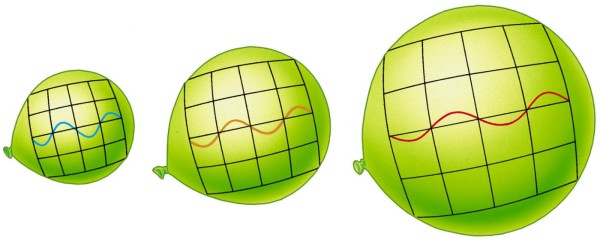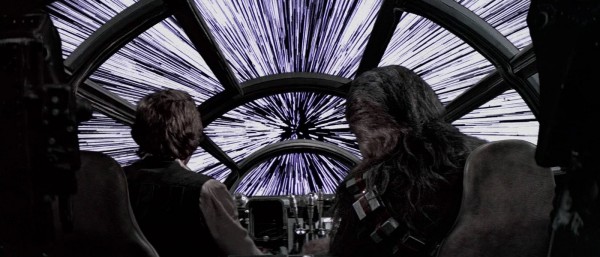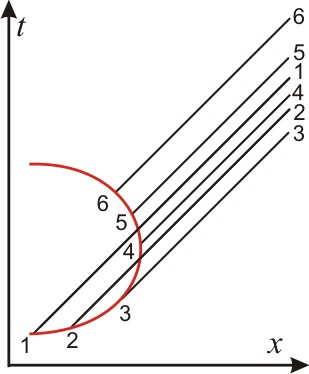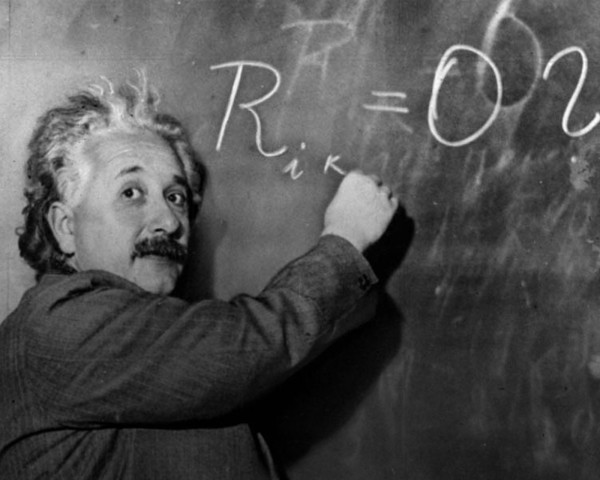"Perhaps in time the so-called Dark Ages will be thought of as including our own." -Georg C. Lichtenberg
There was so much action on Starts With A Bang this week, from darkness to the brightest lights, that it's going to be a bear choosing what to highlight from the comments. Here's what this past week saw:
- The Universe's dark ages (for Ask Ethan),
- The logic that stumped Brooklyn Nine-Nine (for our Weekend Diversion),
- The largest eruption in the known Universe (for Mostly Mute Monday),
- How to travel faster than light without really trying (a great piece from Brian Koberlein),
- Will the LHC be able to test String Theory? (a great answer from Sabine Hossenfelder),
- Jupiter, Io and a cosmic zamboni,
- The legacy of Sally Ride (for our first Throwback Thursday), and
- When we changed the laws of gravity (for a bonus Throwback Thursday).
In addition to these, I had a new piece over at Forbes:
There's so much to cover, so let's not delay; let's go right into your Comments of the Week!
 Image credit: Pearson / Addison-Wesley, via Christopher Palma at http://www2.astro.psu.edu/users/cpalma/astro1h/class28.html.
Image credit: Pearson / Addison-Wesley, via Christopher Palma at http://www2.astro.psu.edu/users/cpalma/astro1h/class28.html.
From John Gaudreault on the expanding Universe during the dark ages: "Given the of the concept of the expansion of space “lengthening” the wavelength of the light and given your illustration of the balloon analogy, the X and the Y and the Z axis would all stretch the same amount as space expanded and therefore the frequency would not change."
There is a mistake in this reasoning. We're used to frequency -- like you see it, above -- being the number of waveforms/wavelengths that vibrate in a certain amount of time between two fixed points. Unlike a guitar string, where he wave propagates at different speeds depending on the tension in the string, blue light, yellow light and red light (in fact, light of all wavelengths) always all propagate at the same speed: the speed of light.
But because of this, there's a simple relationship between the speed of light (c), wavelength (λ) and frequency (f): c = λf. In fact, this relation is true for any wave; simply replace "c" with the velocity (v) of the wave. If you stretch space, you lengthen the wavelength, but the speed of light does not change. Because of this, you must decrease the frequency, which is eminently consistent with what we observe.
It's important to note that this reaction is reversible; if we had our space contract instead of expand, the wavelength would shorten again and the frequency would go back up. Although it appears to be unlikely, this is not physically ruled out as far as what will happen in the far future. But don't be fooled: this expansion isn't happening everywhere. It occurs only in regions where gravitational inhomogeneities haven't overwhelmed the expansion of the Universe. So, in other words, it isn't happening within our local group!
From Tim on the logic of the 12-islanders-on-a-see-saw problem: "What I like about this problem is that it parallels, in an accessible way, the kind of thought processes needed to design a particle physics experiment."
A particle physics experiment is a lot trickier, because a lot of the time you don't know what causes the think you're observing. Many signals are ambiguous, in that they could have arisen from various causes, and it's only by accumulating large amounts of data and quantifying what you get that you could, in practice, determine which portion of the signal was caused by which particle/branch/decay.
Actually, now that I come to think of it, maybe that is like this problem after all! Longtime reader Cleon Teunissen of the Netherlands had sent me a remarkable solution over email. Consider labelling the islanders 1-through-12, and performing the following three weigh-ins:
| 1 | 4 | 6 | 7 | 5 | 9 | 10 | 12 | ||||
| 2 | 5 | 4 | 8 | 6 | 7 | 11 | 10 | ||||
| 3 | 6 | 5 | 9 | 4 | 8 | 12 | 11 |
Think about how this breaks down by considering the islanders in groups of three: 1-3, 4-6, 7-9 and 10-12.
- If 1 is heavier (lighter), the three weighings will tilt: left (right), equal, equal.
- If 2 is heavier (lighter), the three weighings will tilt: equal, left (right), equal.
- If 3 is heavier (lighter), the three weighings will tilt: equal, equal, left (right).
- If 4 is heavier (lighter), the three weighings will tilt: left (right), left (right), right (left).
- If 5 is heavier (lighter), the three weighings will tilt: right (left), left (right), left (right).
- If 6 is heavier (lighter), the three weighings will tilt: left (right), right (left), left (right).
- If 7 is heavier (lighter), the three weighings will tilt: left (right), right (left), equal.
- If 8 is heavier (lighter), the three weighings will tilt: equal, left (right), right (left).
- If 9 is heavier (lighter), the three weighings will tilt: right (left), equal, left (right).
- If 10 is heavier (lighter), the three weighings will tilt: right (left), right (left), equal.
- If 11 is heavier (lighter), the three weighings will tilt: equal, right (left), right (left).
- If 12 is heavier (lighter), the three weighings will tilt: right (left), equal, right (left).
Note that there are, with three possible outcomes (left, right, equal) and three weighings, there are only a total of 3 × 3 × 3 = 27 outcomes, and this accounts for 24 possibilities, demonstrating that you cannot solve for more than 12 islanders, total, using the see-saw only three times. (Consider, also, that equal, equal, equal tells you nothing about who could be lighter or heavier.)
This is a lot of unnecessary people on the see-saw, but it's nice to have a single foolproof method, and something I thought was a worth addition to my labor-intensive solution!
Image credit: NASA, ESA, CXC, STScI, and B. McNamara (University of Waterloo) / NRAO, and L. Birzan and team (Ohio University).
From See Noevo on the largest eruption in the Universe: "I thought black holes couldn’t emit anything."
That's true, if by "emit anything" you mean "from inside the event horizon to outside the event horizon." But everything you're seeing in this image was emitted from outside the event horizon and remained outside the event horizon at all times. Just because much of the emitting matter wound up, afterwards, inside the black hole, doesn't pose a problem for this type of phenomenon. Note that this applies to all quasars, AGNs, blazars, magnetars, active black holes and microquasars everywhere in the Universe.
From Ken Ziebarth on "breaking" the speed of light: "The one I like is sweeping your laser pointer across the moon. The edge of its beam moves across the lunar surface faster than c!"
Of course, that's merely an optical phenomenon, not anything truly breaking the cosmic speed limit. Then again, so was every example in the post Brian wrote: nothing ever exceeds c, which is exactly the way it should be.
Michael Kelsey was good enough to point out that there was a post on this topic just two months ago, as Sabine graced us with an excellent writeup of what we call Photonic Booms.
I still can't think that in my head without hearing Guile from Street Fighter 2's voice.
Image credit: © WGBH Educational Foundation, via http://www.pbs.org/wgbh/nova/physics/conversation-with-brian-greene.html.
From Sinisa Lazarek (and seconded by Denier and thirded by Ragtag Media): "Another great article by Sabine! Wish she was at Perimeter talking more on LQG instead of Lego-land lecture. Loop [Quantum] Gravity…. which for reasons unknown to me, is sadly never covered on this blog."
I am very lucky to have Sabine contributing here, and I agree that she writes great articles. (I was extra lucky to get two from her this month!) She and I have corresponded about which idea for quantum gravity I prefer the best, and it's neither string theory nor LQG but Asymptotic Safety. It will be a lot of work -- and it's way too long for a comments-of-the-week snippet -- but I will consider doing the next Ask Ethan on quantum gravity, which will be hard but I'll try my best. If that's what you really want, by the way, I highly recommend submitting your questions/suggestions for a column on it; I'll consider every unique submission on it I receive as a "vote" saying it's what you want! (And yes, Ragtag, I will know if you send multiple entires in!)
Image credit: NASA Planetary Photojournal, via https://solarsystem.nasa.gov/multimedia/display.cfm?IM_ID=2155.
From Cleon Teunissen on Io's surface and Jupiter's tides: "Interestingly, like our Moon Io is in tidal lock; Io rotates around its axis with the same period as its orbit around Jupiter.
As mentioned by Ethan: besides the tides of the oceans the Earth has a solid Earth tide as it rotates relative to the Sun and Moon.
Io doesn’t have that kind of tide, as Io is in tidal lock. In the case of Io the periodic deformation is due to the fact that Io’s orbit is not quite circular. As Io moves closer and further away from Jupiter the magnitude of Jupiter’s tidal effect changes.
The wikipedia article about Io also mentions that the change in tidal bulge from closest-to-Jupiter to farthest away may be as much as 100 meters (the radius of Io is about 1800 kilometer)
The amount of change of tidal bulge causes internal deformation, the friction heats Io up.
I wonder: is the amount of tidal bulge change large enough to crack Io’s surface? I estimate it’s still within the range of elastic deformation. (Just as on earth a rock surface does not necessarily crack when there is an earthquake. Mostly the size of the seismic waves is within the range of elastic deformation that the rock is capable of.)
Of course, the surface of Io is continuously cracked allright: by vulcanism."
You're asking (and pretty much answering for yourself) what seems like two separate questions. Here are some facts we are certain of: Io does experience tides; these tides are affected by the orbits of the other Jovian moons; Io is tidally locked to Jupiter but has an elliptical orbit, so stretches and is squeezed by up to ~100 meters; this heats up the interior of Io tremendously, so that we think the entire core is fully molten.
But what about the surface of Io? The best we have is imagery from Voyager 1 and Galileo, which is the highest resolution stuff we've got:
At this resolution, we can't see cracks in the surface. My guess is that they're there, but it's only a guess. But it's also conceivable that any weakness in the surface that would potentially lead to a crack would give way to a full-scale eruption before any cracking occurs.
This is a question that the data is not sufficient to answer, as far as I know. The deformation stresses are certainly sufficient to crack Io's surface, but it's plausible that something else -- volcanism -- beats the cracking effect of the moonquake to the punch. I was hopeful that the next NASA mission to Jupiter, JUNO, would answer questions like this, but it's a Jupiter-only mission, not designed to probe its moons. We'll have to wait for the next one!
Image credit: NASA, via http://www.nasa.gov/centers/kennedy/about/ride-feature_prt.htm.
From Denier on Sally Ride: "Sally Ride was smart, driven, and accomplished what she set out to accomplish. Period. She is admirable and I’m glad you recognize that. And glad Google recognized that. It is with great pride that those of us here in San Diego could say that our community includes people such as Sally Ride.
That being said, what does Sally Ride’s sexual preference have to do with anything? Seriously, WTF?"
Well, let's consider what her sexual preference has to do with anything. As of Sally Ride's death in 2012, there were 330 American men and women who had gone into space. Guess how many of them were openly gay, lesbian or bisexual?
Did you guess zero?
It was zero. Now 219 of those 330 were former military, which only ended policies such as Don't Ask, Don't Tell in 2011, so that accounts for a full 2/3 of the astronauts. But it doesn't change this fact: Sally Ride -- upon her death -- became the only openly non-100%-heterosexual American in space.
But maybe that wouldn't be enough to convince you that it matters. Instead, consider this report from Natalie Wolchover:
Although NASA does not discriminate on the basis of sexual orientation, Michael Cassutt, author of five books and hundreds of articles about human spaceflight, said coming out would until recently have been "a career-wrecker" for an astronaut. "Not for any formal reason, but in the same way that any medical issue or even some kind of notoriety has been an astronaut career-wrecker... Any issue that detracts from the mission is or has been the kind of thing an astronaut wants to avoid. It isn't NASA politics; it is NASA politics as practiced at the astronaut office."
So maybe it doesn't have anything to do with anything, but the fact is that if you want to work as an astronaut, thee's an unwritten "code of conduct" that you can't be a distraction from the mission, and it appears that even today, being openly gay, lesbian or bisexual would be perceived as a distraction. Perhaps we still have a ways to go.
And finally, from Fry on relativity, Einstein and then some: "As much as E=mc^2 looks elegant, it also strikes me as “too simple to be useful”."
On the contrary, I think it's exactly simple enough -- and no simpler -- to be eminently useful. You go on to say that this is the equivalence between energy and rest mass, and that's absolutely right. Many people denote that "m" in E = mc^2 as m0, to specifically refer to rest mass. This is particularly useful when we talk about particle creation/annihilation, physics in the center-of-mass reference frame, and reduction to non-relativistic terms.
You can make it more complicated and more useful, but often the key to being good at physics (or life in general) is to recognize what's important in a given situation and what's unnecessarily overcomplicating matters. In some cases, the full E = sqrt ( m^2 c^4 + p^2 c^2 ) is more useful, in others, E = mc^2 gives you everything you need. When Newtonian gravity and GR give indistinguishable predictions, which one will you use? Because I know what I'm choosing!
Thanks for a great week, everyone, and while I expect to see you all next week, make sure you come back tomorrow for a special announcement! I'll see you all then!









Hey, could you do an article about the militarsation of space/armsrace in space? It's going on right now. For further information use Google search, there are a lot of articles on this.
I think people should be aware of it.
https://en.wikipedia.org/wiki/Militarisation_of_space#Space_warfare
I don't intentionally try to stuff the ballot box, perhaps I am not sure of the cut off time for the week.
I am going to drop a new one in today If I can't get Mike from the SLAC Laboratory to answer it.
Kinetic energy is transformed into rest energy. Blabla
@Ragtag Media #2: I posted my vote for a quantum gravity article; please add your voice to the rather thin chorus :-)
Awesome Michael, I was just looking at this article yesterday:
http://phys.org/news/2015-05-slac-gears-dark-lux-zeplin.html
Will you be a part of that?